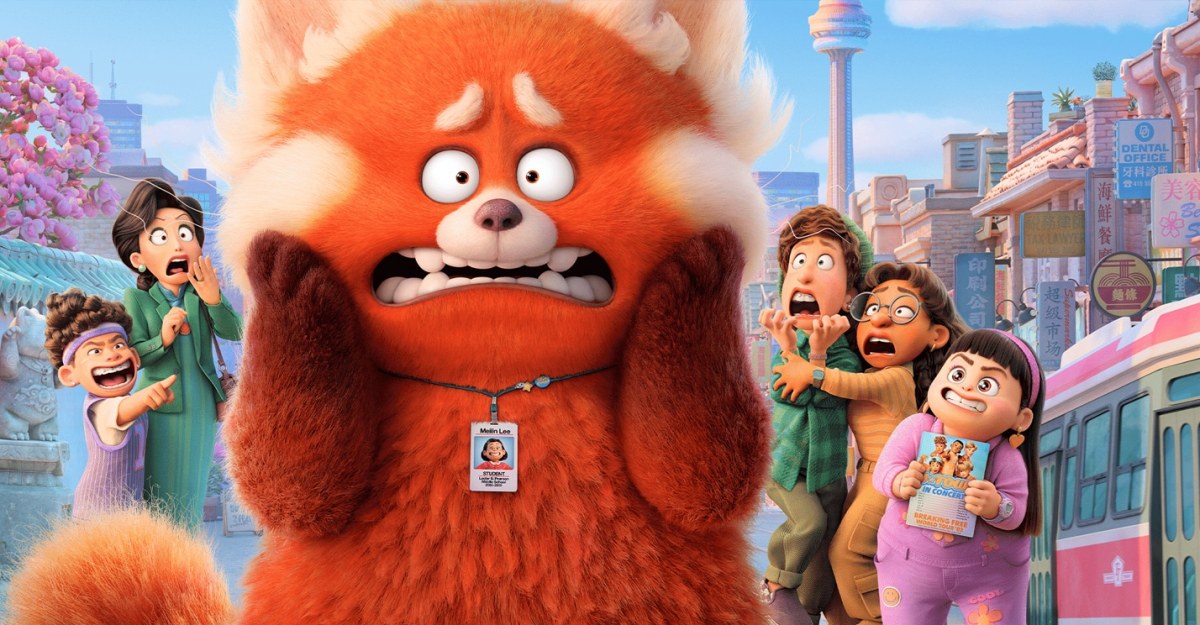Turning Red released on Disney+ this Friday.
Critical response to the movie has been extremely positive. It seems highly likely that the movie will be a massive hit on the streaming service, much like Encanto and Luca before it, animated family-friendly films that are perfect for kids and adults looking to watch a magical movie together. While Turning Red might not be the best film that the studio ever produced, it is a reminder of the charm of what might be termed “post-peak Pixar” — a quirky and engaging film told from a unique perspective.
Turning Red is the story of Meilin “Mei” Lee (Rosalie Chiang), a 13-year-old girl growing up in Toronto. Mei is a hardworking over-achiever who pushes herself to impress her loving mother Ming (Sandra Oh). Mei has a bright future ahead of her, only for her life to take a dramatic swerve when she suddenly starts transforming into a giant red panda in response to any emotional stimulation. Suddenly, Mei’s life is turned upside down — especially her relationship with her mother.
It’s a classic fantastical coming-of-age tale, a story about puberty coached in a none-too-subtle metaphor. It’s basically a riff on the classic teenage body transformation template that includes movies like Rod Daniel’s Teen Wolf and Sam Raimi’s Spider-Man. It’s clever and funny, written with a sharp eye on its characters, and directed with an infectious enthusiasm for animation as a medium. It’s a fitting companion piece to director Domee Shi’s previous project, the short film Bao.
Unfortunately, Turning Red has become a flashpoint for some limitations of modern critical discourse. The website CinemaBlend ran a review of the movie essentially arguing that it was a film that existed so far outside the writer’s frame of reference that they lacked any ability to relate to it. “Turning Red needs to ramp up its nervous system and plug directly into the mindset of a young woman. It’s… a lot,” the review wrote. “It wore me out.” The review gave it one-and-a-half-stars.

The review noted that under Pete Docter, Pixar had “turned its reigns [sic] over to fresh voices” but complained that this resulted in “less universal” stories. “There’s an audience out there for Turning Red,” the review notes in its final paragraph. “In my opinion, however, that audience is relatively small, and I’m not part of it.” The response to this review was strong and immediate. CinemaBlend has since deleted the review, perhaps in acknowledgement of this.
This article isn’t about attacking the critic in question personally. More than that, it is worth stressing that people like what they like, that no opinion about film is objective, that taste varies. This argument isn’t about any of that. It’s entirely possible for a person to dislike a movie for all sorts of reasons. That is human nature. However, it is worth engaging with the argument being advanced in that review, because it is something that is depressingly common in modern film discourse.
Before engaging with the substance of the argument — the idea that a movie’s worth is measured by how “universal” it is — it is worth trying to unpack exactly just how Turning Red is “less universal” than the Pixar movies that were made before Pixar turned its reins over to a younger generation. It is a small point, but it is an important one. It’s important to establish what exactly is being used as the frame of reference for this discussion.
Turning Red is a story about a young girl in turn-of-the-millennium Toronto. How is that harder to relate to than a young fish in Finding Nemo, a lonely robot in Wall-E, or a rat in Ratatouille? CinemaBlend gave overwhelmingly positive reviews to those movies, suggesting no limit on their hypothetical audiences. The critic in question gave a rave review to Shazam!, another movie about a teenager who undergoes a magical and metaphorical transformation.

It seems like the implication that what separates Turning Red from movies like Shazam! is that it is a movie about a young Chinese-Canadian girl rather than a young white guy. It is frustratingly similar to the weird arguments that anything featuring a diverse central cast must be “woke,” regardless of the actual content of the media in question. There’s the uncomfortable implication that the story of Mei Lei is somehow less relatable to audiences than stories about fish, robots, or rats.
Turning Red is a wonderfully accessible movie, tapping into universal themes. Given that most audience members have or will come of age, there is a universality to coming-of-age narratives. The success of Star Wars as a franchise and cultural institution suggests that a pretty significant audience can at least engage with the idea of generational conflicts between children and parents. Turning Red is not the work of Andrei Tarkovsky or Andy Warhol. It’s a fun and enjoyable film about being a teenager.
That said, there is undeniably some specificity to Turning Red — a perspective that does distinguish the film from Teen Wolf or Spider-Man. This is good, as Teen Wolf and Spider-Man are already films that exist. Turning Red does foreground a female perspective and an Asian perspective (and, yes, even a Canadian perspective) on these familiar tropes. It looks at how, while a lot of the general experience is shared and common, there are some finer and richer details in the margins.
Historically, women have largely been excluded from these sorts of narratives. Turning Red is notable for being the relatively rare family movie to acknowledge menstruation, which is a fact of life for a whole swath of people going through puberty but is rarely acknowledged as such. It is strange to argue that something that is seldom discussed but affects more than half the world’s population can make a movie “less universal.” It allows women to see themselves on screen, but it also affords men a chance to understand an experience they’ll never have.

There’s an irony here. Baked into this criticism of Turning Red is the idea that cinema should be constructed for the gaze of a presumed straight, white, and male audience. That is the implied “universal” audience. It is the unspoken “default.” However, such an extreme reaction to a film that even acknowledges an alternative viewpoint demonstrates how complacent that gaze is. Even a film as accessible and charming as Turning Red is treated as exhausting.
That criticism of Turning Red is oblivious to the possibility that other audiences may have felt similarly excluded by films like Teen Wolf or Spider-Man. The review is so upset at the possibility that the film may have been constructed without prioritizing the reviewer’s perspective that it fails to consider that there are any number of audiences who have never had their perspectives even acknowledged. This is particularly important for children, who deserve to see that there is space for people like them in these stories.
However, what is most frustrating is just how incurious and solipsistic this criticism is, how it exists in direct opposition to the central appeal of cinema as a medium. Indeed, it’s not just this review. It’s an increasingly common and prevalent critical argument in certain online circles. It is a rejection of the idea of perspective or meaning. It’s the idea that films exist largely to flatter their audiences with familiarity, rather than offer anything outside their experience.

The very medium of cinema is about seeing the world through somebody else’s eye. The audience is peering through a window, their gaze guided by the hand behind the camera. A well-made movie of any kind, whether an intimate indie or a big-budget blockbuster, is about somebody showing the viewer how they see the world. This is one of the reasons why it is so frustrating to see online discourse rejecting artists and embracing corporate fandom.
For all that watching a movie can seem like a passive experience, a film is a conversation. It’s about observing and engaging as much as parroting and echoing. Audience members bring something to it. However, they get more from the experience if they are interested in something beyond themselves. That is the majesty of Finding Nemo, Wall-E, and Ratatouille. It is also the majesty of Coco, Soul, Luca, and Turning Red. Movies can take us to distant worlds and other galaxies, but also inside the heads and hearts of others. In doing so, cinema has the power to render the specific universal.
“We are who we are,” argued the great film critic Roger Ebert. “We are kind of stuck inside that person, and the purpose of civilization and growth is to be able to reach out and empathize a little bit with other people, find out what makes them tick, what they care about. For me, the movies are like a machine that generates empathy.” It seems safe to argue that the world could always use a little more empathy and curiosity, and that maybe the best critics understand that.






Published: Mar 13, 2022 11:00 am